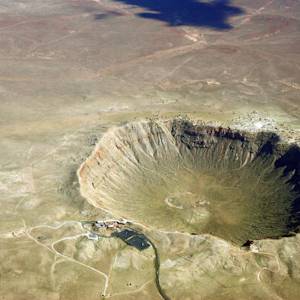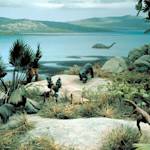5th Mass Extinction, End Cretaceous
66 million BCE • Chicxulub Crater, Yucatan, Mexico
“The asteroid hit. The air in front was compressed and violently heated, and it blasted a hole through the atmosphere, generating a supersonic shock wave... In that moment, the Cretaceous period ended and the Paleogene period began... Within two minutes of slamming into Earth, the asteroid, which was at least six miles wide, had gouged a crater about eighteen miles deep and lofted twenty-five trillion metric tons of debris into the atmosphere... Much of the material was several times hotter than the surface of the sun, and it set fire to everything within a thousand miles... The asteroid was vaporized on impact. Its substance, mingling with vaporized Earth rock, formed a fiery plume, which reached halfway to the moon... fires consumed about seventy per cent of the world’s forests... The dust and soot from the impact and the conflagrations prevented all sunlight from reaching the planet’s surface for months. Photosynthesis all but stopped, killing most of the plant life, extinguishing the phytoplankton in the oceans, and causing the amount of oxygen in the atmosphere to plummet... Earth’s two essential food chains, in the sea and on land, collapsed. About seventy-five per cent of all species went extinct. More than 99.9999 percent of all living organisms on Earth died... before the asteroid struck, mammals scurried about the feet of the dinosaurs... [but] when the dinosaurs were gone it freed them.... In the next epoch, mammals underwent an explosion of adaptive radiation, evolving into a dazzling variety of forms, from tiny bats to gigantic titanotheres, from horses to whales, from fearsome creodonts to large-brained primates with hands that could grasp and minds that could see through time.”
source: “The Day the Dinosaurs Died” Douglas Preston, The New Yorker, 4/8/2019.
image source: Complete Tyrannosaurus rex skull, AMNH 5027. American Museum of Natural History. Public Domain via wikimedia commons.


Learn about Maya Lin’s fifth and final memorial: a multi-platform science based artwork that presents an ecological history of our world - past, present, and future.

Discover ecological histories and stories of former abundance, loss, and recovery on the map of memory.

Learn how we can reduce our emissions and protect and restore species and habitats – around the world.

See how art can help us rethink the problems we face, and give us hope that each one of us can make a difference.

Help make a global memorial something personal and close to home. Share your stories of the natural world.


